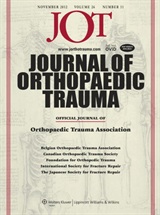Incisional negative pressure wound therapy after high-risk lower extremity fractures 
Stannard JP, Volgas DA, McGwin G 3rd, Stewart RL, Obremskey W, Moore T, Anglen JO
J Orthop Trauma. 2012 Jan;26(1):37-42. doi: 10.1097/BOT.0b013e318216b1e5
Funding: Industry funded
Sponsor: Kinetic Concepts, Inc.
Conflicts: None disclosed
Therapy Level II – Randomized Trial
Aims
To investigate negative pressure wound therapy (NPWT) to prevent wound dehiscence and infection after high-risk lower extremity trauma.
DESIGN:
Prospective randomized multicenter clinical trial.
SETTING:
Four Level I trauma centers.
Population
Blunt trauma patients with one of three high-risk fracture types (tibial plateau, pilon, calcaneus) requiring surgical stabilization.
INTERVENTION:
- Incisional NPWT (Group B) was applied to the closed surgical incisions of patients randomized to the study arm of this trial,
CONTROLS
- standard postoperative dressings (Group A) were applied to the control patients.
Outcomes
Acute and chronic wound dehiscence and infection.
RESULTS:
- Two hundred forty-nine patients with 263 fractures have enrolled in this study with 122 randomized to Group A (controls) and 141 to Group B (NPWT).
- There was no difference between the groups in the distribution of calcaneus (39%), pilon (17%), or tibial plateau (44%) fractures. There were a total of 23 infections in Group A and 14 in Group B, which represented a significant difference in favor of NPWT (P = 0.049).
- The relative risk of developing an infection was 1.9 times higher in control patients than in patients treated with NPWT (95% confidence interval, 1.03-3.55).
CONCLUSIONS:
- NPWT is an effective prophylactic treatment to prevent infection and wound dehiscence of high-risk surgical incisions.
- These surgeons have found a decreased incidence of wound dehiscence and total infections after high-risk fractures when patients have NPWT applied to their surgical incisions after closure.
- There is also a decrease in acute infections after NPWT
- NPWT should be used in high risk wounds after surgery
Ref:
1. http://www.ncbi.nlm.nih.gov/pubmed/21804414
2. http://journals.lww.com/jorthotrauma/pages/articleviewer.aspx?year=2012&issue=01000&article=00007&type=abstract
Leave a Reply